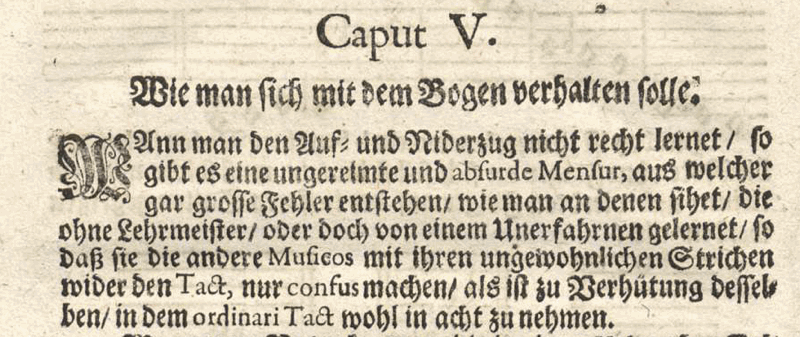A Timeline history of the Violin Bow - from c. 1600 - 1800
... the sources in detail ...
Daniel Merck (c.1650 − 1713)
Compendium Musicae Instrumentalis Chelicae, (Augsburg, 1695)
Merck's Compendium Musicae Instrumentalis Chelicae is expressly written for students and amateurs (Der Jugend und andern Liebhabern zu Gefallen aufgeseßt).

"How one should manage the bow.
If one has not learnt the up and down strokes correctly, this leads to an unordered and absurd measure, from which really big mistakes arise, as one sees in those who have learnt without a teacher, or indeed from an inexperienced teacher, who with their peculiar strokes against the bar only confuse the other musicians - so it is as precaution against that to take care in ordinary time (4/4)".
The first three chapters are devoted to basic theory - clefs, note-names, lengths etc. In chapter IV he looks at the strings of the violin, and basic fingering. In Chapter V we come to the bow -

"How one should manage the bow.
If one has not learnt the up and down strokes correctly, this leads to an unordered and absurd measure, from which really big mistakes arise, as one sees in those who have learnt without a teacher, or indeed from an inexperienced teacher, who with their peculiar strokes against the bar only confuse the other musicians - so it is as precaution against that to take care in ordinary time (4/4)".
He proceeds to give simple examples in 4/4, with the by now familiar adjusting when needed to keep down bows on main beats. One peculiarity, he is very clear that a crotchet followed by two quavers is to be played down-down-up, and not down-up-up (n= Niderzug = down bow, a = Aufzug = up bow);

In Chapter VI he proceeds to triple time: first theoretical, explaining how the notes are sub-divided etc, and then on to the bowing. Here he points out that you must use a down bow at the beginning of every bar, and that a little note after a rest or a dotted note must be played with an up bow. He manages to avoid altogether the situation of three equal notes in a bar - although his last sentence in the chapter might suggest that the norm for him is down-up-down.

In Chapter VI he proceeds to triple time: first theoretical, explaining how the notes are sub-divided etc, and then on to the bowing. Here he points out that you must use a down bow at the beginning of every bar, and that a little note after a rest or a dotted note must be played with an up bow. He manages to avoid altogether the situation of three equal notes in a bar - although his last sentence in the chapter might suggest that the norm for him is down-up-down.
"Man darff in den Triplen gar wohl zweymahl aufziehen/ bevorab/ wann es geschwind gehet. Die Ubung wird es selbst an die Hand geben."
"One may, in triple time, play two ups after another, especially when it's fast. Practice will enable this"
"One may, in triple time, play two ups after another, especially when it's fast. Practice will enable this"
In Chapter VII he explains a few more terms and signs - repeat, fermata, slur (notes to be taken in one bow!), t meaning trill, // meaning mordent (although he makes no distinction between the two in terms of direction) and, important for those playing Biber, he explains that m means vibrato:
"m. wo dises stehet muß fest zugedruckt werden mit dem Finger aber die ganze Hand bewegt werden"
"Where m is written one must push firmly with the finger, but move the whole hand"
"Where m is written one must push firmly with the finger, but move the whole hand"
He mentions but declines to discuss the terms Spiccato or Harpeggiato, as they appear in Biber, Walther et al, explaining that they are too advanced for such an elementary tutor.
At the very end, after Chapter VIII (elementary discussion of playing in positions, tuning, and stringing), he concludes with a "few remarks", a couple of which are relevant here: First, the learner should "accustom himself to a nice long stroke, and above all should not rush the up bow"
And secondly, if rather disappointingly (but perhaps not unexpectedly) - "How the bow is to be held, you should learn yourself."
At the very end, after Chapter VIII (elementary discussion of playing in positions, tuning, and stringing), he concludes with a "few remarks", a couple of which are relevant here: First, the learner should "accustom himself to a nice long stroke, and above all should not rush the up bow"
And secondly, if rather disappointingly (but perhaps not unexpectedly) - "How the bow is to be held, you should learn yourself."